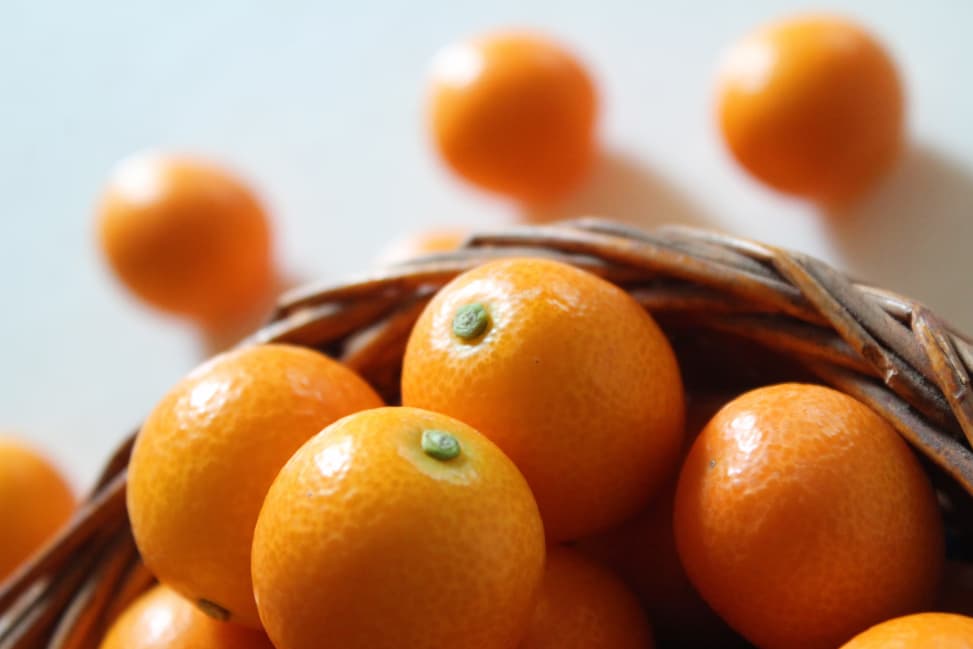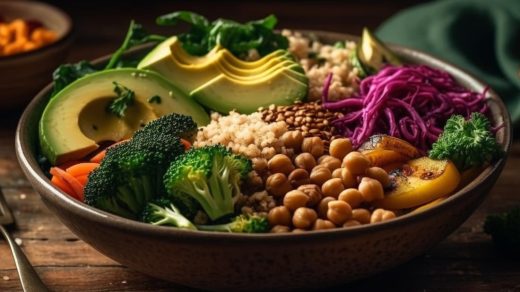Have you ever tried a kumquat? These tiny, tangy-sweet fruits may be small, but they pack a big punch when it comes to flavor and nutrition.
Kumquats are a unique citrus fruit that you can pop in your mouth and enjoy whole-peel and all!
Kumquat Fruit Nutrition Facts and Health Benefits

Credit: Photo by Jeremy Bishop on Unsplash
Let’s dive in and explore what makes kumquats so special.
What are Kumquats?
Kumquats are the small, oval, or round fruits of the Fortunella tree, which is native to mountainous parts of China.
The trees were named after botanist Robert Fortune, who first brought kumquats from China to Europe in the mid-1800s.
Today, kumquats are grown for their delightful fruits and as ornamental trees in many parts of the world, including the United States.
There are a few main types of kumquats:
- Nagami kumquat (Fortunella margarita): This is the most common variety in the US. It has an oval shape and a tart, lightly sweet flavor.
- Marumi kumquat (Fortunella japonica): Round in shape with a sweeter taste.
- Meiwa kumquat (Fortunella crassifolia): A round variety that is larger than the others. Popular in Japan.
- Hong Kong Wild (Fortunella hindsii): The smallest kumquat variety.
What sets kumquats apart from other citrus is that you can eat them whole – peel and all! The peel is sweet, while the pulp inside is tart, creating a delightful contrast.
The fruits are small, only about the size of a large olive. They have a shiny, smooth bright orange skin when ripe.
Kumquat Fruit Nutrition Facts
Don’t be fooled by their small size – kumquats are nutrient powerhouses! Take a look at all the vitamins, minerals, and beneficial plant compounds packed into these tiny fruits:
Kumquat Nutrition per 100 grams (3.5 oz):
| Nutrient | Amount | % Daily Value* |
|---|---|---|
| Energy | 71 kcal | 3.5% |
| Carbohydrates | 15.9 g | 12% |
| Protein | 1.88 g | 3% |
| Fat | 0.86 g | 4% |
| Fiber | 6.5 g | 17% |
| Vitamin C | 43.9 mg | 73% |
| Vitamin A | 290 IU | 10% |
| Calcium | 62 mg | 6% |
| Iron | 0.86 mg | 11% |
| Potassium | 186 mg | 4% |
Percent daily values are based on a 2000 calorie diet.
Source: USDA
Some Key Nutritional Highlights of Kumquats:
- Excellent source of fiber, with 6.5 grams per 100 g serving (17% daily value). The peel contains pectin and other beneficial fiber.
- Very high in vitamin C, providing 73% of the recommended daily amount in a 100 gram serving. Vitamin C is a potent antioxidant.
- Good source of vitamin A, with 10% of the daily value per serving. Vitamin A is important for vision, immune function, and reproduction.
- Contains smaller amounts of B vitamins, vitamin E, calcium, iron, potassium, copper, and manganese.
- Rich in beneficial plant compounds like flavonoids, carotenoids, and essential oils, which have antioxidant and anti-inflammatory effects.
The combination of nutrients and phytonutrients in kumquats makes them a great choice for supporting overall health. Let’s explore some of the potential benefits!
Top 8 Health Benefits of Kumquats:
- May support immune function: The high vitamin C content of kumquats may help keep your immune system strong. Vitamin C stimulates the production and function of white blood cells. It also acts as an antioxidant, protecting cells from damage.
- Promote healthy skin and collagen production: Vitamin C is necessary for producing collagen, a protein that keeps skin firm and elastic. The antioxidants in kumquats also help protect skin from sun damage and aging.
- Support eye health: Kumquats contain the antioxidants lutein, zeaxanthin, and vitamin A (in the form of beta-carotene), which are all important for healthy vision. They may help lower the risk of age-related macular degeneration and cataracts.
- May have anticancer potential: The flavonoids and other antioxidants in kumquats help fight harmful free radicals and may reduce inflammation. Chronic inflammation and oxidative stress are linked to the development of various cancers. While more research in humans is needed, test-tube and animal studies show some anticancer effects of compounds in citrus peel.
- Support heart health: The high fiber content of kumquats may help lower cholesterol levels and reduce the risk of heart disease. Soluble fiber can bind to cholesterol and remove it from the body. The antioxidants in kumquats may also help improve blood vessel function and reduce inflammation, which is important for a healthy heart.
- May aid in blood sugar management: Despite their sweet taste, kumquats have a low glycemic index and are generally considered safe for people with diabetes when eaten in moderation. The fiber helps slow the absorption of sugar into the bloodstream. Some research also suggests that certain compounds in citrus may improve insulin sensitivity.
- Benefit digestive health: The high fiber content of kumquats, particularly from the peel, may help promote healthy digestion and regularity. Fiber is important for adding bulk to stools, promoting regular bowel movements, and feeding the beneficial bacteria in the gut.
- May have anti-inflammatory effects: Kumquats are rich in plant compounds like flavonoids that have anti-inflammatory properties. Chronic inflammation is linked to many diseases, including heart disease, diabetes, and certain cancers. Including kumquats and other antioxidant-rich foods in your diet may help lower inflammation in the body.
While kumquats offer impressive potential benefits, remember that they are not a magic bullet. They should be enjoyed as part of an overall balanced diet and healthy lifestyle.
Selecting and Storing Kumquats
Kumquats are in season during the winter months, usually from November through June in the US. Look for fruits that are bright orange, firm, and free of blemishes or soft spots. Avoid any that are green, as this indicates they are not fully ripe.
Ripe kumquats can be stored at room temperature for a few days. For longer storage, place them in a plastic bag in the fridge, where they can last up to a few weeks. Kumquats can also be frozen whole or as a puree for later use.
Preparing and Serving Kumquats
The great thing about kumquats is that they require very little prep. Simply rinse them under cool water and they’re ready to enjoy!
You can eat kumquats whole, peel and all. Many people like to give them a gentle squeeze or roll between their fingers first to release the essential oils in the skin and meld the sweet and tart flavors.
Some tasty ways to enjoy kumquats include:
- Eating out of hand as a snack.
- Slicing and adding to salads or grain bowls.
- Use as a garnish for cocktails or sparkling water.
- Making kumquat marmalade, jam, or chutney.
- Candying the slices for a sweet treat.
- Baking into cakes, muffins, or pies.
- Simmering into a sauce for meat or fish dishes.
Get creative and have fun experimenting with this unique fruit!
Kumquat Tips and Tricks
- Gently roll the kumquat between your fingers before eating to release the flavorful essential oils in the peel.
- If the tartness is too intense for you, try slicing the kumquat in half and scooping out the pulp to eat on its own. The peel is the sweetest part.
- Kumquats make a great addition to meat or fish marinades. Slice them thinly and add to your favorite marinade recipe.
- For an easy and impressive appetizer, slice kumquats into rounds, add a small piece of cheese (like chevre or brie) and a snippet of fresh herb, then skewer with a toothpick.
- Make your own kumquat-infused liquor! Simply add halved or sliced kumquats to a mason jar, cover with vodka or another liquor of choice, and let infuse for at least 3 days before straining and using.
- Thinly sliced kumquats make a beautiful garnish for desserts like panna cotta, cheesecake, or ice cream.
Are kumquats safe for everyone?
Kumquats are generally considered safe for most people when consumed in normal food amounts. However, some people may be allergic to citrus fruit. If you have a citrus allergy, avoid kumquats.
As with all fruits, it’s best to introduce kumquats slowly to infants and young children to asses any potential reactions. For most people though, including them in the diet is perfectly healthy.
The seeds and peel of kumquats do contain small amounts of potentially toxic compounds like cyanogenic glycosides. However, the amounts are so low that they are unlikely to cause issues unless very large amounts of kumquats are consumed.
If you have any concerns, consult your healthcare provider. Those on medications or with medical conditions may want to check to ensure kumquats are safe for their situation.
More Related Guides:
Sources:
- Stanford School of Medicine Cancer information Page- Nutrition to Reduce Cancer Risk.
- www.agroforestry.org– Citrus and Fortunella-pdf.
Conclusion:
So there you have it – the tiny but mighty kumquat! These little fruits are truly unique in the citrus family. With their sweet-tart flavor and ability to be eaten whole, they’re a fun and tasty addition to the diet.
Kumquats are incredibly nutritious, packing a good amount of fiber, vitamin C, vitamin A, and beneficial plant compounds into each small fruit. Enjoying them regularly may support many aspects of health, including immunity, skin and heart health, digestion, and more.
While they can certainly be part of a healthy diet, remember to consume kumquats in the context of an overall balanced eating pattern and lifestyle. With their flavor and versatility though, that’s an easy and enjoyable thing to do!
So the next time you spot kumquats at your farmer’s market or grocery store, give them a try. Your taste buds and your body will thank you.



